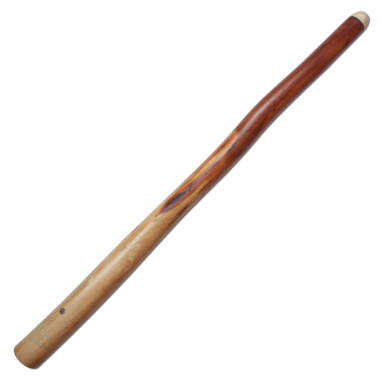Wix Stix Sunset 0455
Why is this didg takes part of the Selection Gauthier Aubé? In addition to being a long-time friend, Gauthier is in my eyes one of the most inspiring musicians on the current didgeridoo scene. It was therefore quite natural that I proposed to him to collaborate on a selection of instruments.
The idea is simple: Gauthier chooses and recommends didgeridoos of didgeridoo-passion that he particularly likes. Each selected didgeridoo corresponds to its requirements: balance, playing comfort, sound richness, precision... Gauthier is recognized for his technical insight but also for his pedagogical approach, which makes him an excellent guide for all enthusiasts looking for a good instrument! For each model in this selection, you will find a video of Gauthier playing it and his commentary, so you can hear his potential and better feel what he has to offer.
Comments from Gauthier : Definitely one of my favorites in this selection. It has everything going for it: incredibly warm sound and I mean really warm amazing low harmonics, and great playability. An instrument with few flaws and many qualities.
My comments: A enthusiast who takes time in manufacturing, quality before quantity! Bruce started making didges in the mid-90s, this passion is still strong 30 years later! All Bruce trunks have been dried for a minimum of 12 months before being processed. Bruce does not use wax to reduce the size of his mouthpieces. Either the hole is the right diameter and in this case Bruce works the mouthpiece in a natural way. Either he uses an embouchure insert. A real plus for getting the most comfortable mouthpiece! Bruce's didgeridoos have an unbeatable quality of manufacturing, finish, playability and price ratio.
Why Sunset? Sunset means sunset in English. Yes but why ? Bruce told me the story of the trunk he used to make this didgeridoo. After a long day of cutting, Bruce wanted to go home but he remembered wanting to find an "open" trunk for a modern column. At the end of his day, when the sun was setting and Bruce was going home, he observed the sunset and in the last rays he saw this eucalyptus! He wanted to mark his symbol of the sunset with a turquoise inlay on the bell! Ash mouthpiece with Lightning Ridge opal inlays.
- Instrument guaranteed for 1 year
- Shipping costs are free! (only for France)
- Didgeridoo Passion also offers you the carrying case!
Classification
This scale is the result of an air column/bell start ratio If we divide the diameter of the bell with that of the beginning of the air column we get a number between 1.5 and 3.5. We can classify all the didgeridoos in 4 large families. Each family groups the instruments with a similar character, simply based on the overall shape of the air column (conical/cylindrical) and on the diameter of the column (wide/narrow). The result is a simple and very reliable reading grid, making it easier to search and purchase on line.
The diameters are measured with a caliper, start of the air column after the mouthpîece. This ratio is very reliable for a didg having a air column with a 'smooth' internal work, in the case of a hollowed eucalyptus instrument it give an approach of the instrumental character.

Bruce Wix Stix
Bruce Wix, maker of WixStix didgeridoos
A enthusiast who takes time in manufacturing, quality before quantity!
Bruce started making didges in the mid-90s, this passion is still strong 30 years later! He works with three different types of eucalyptus:
- Woolybutt
- Ironbark
- Box
All of its termite didges come from North Queensland and cut by a renowned Aboriginal owner. All its trunks were dried for a minimum of 12 months before being worked. Bruce does not use wax to reduce the size of his mouthpieces.
Either the natural hole is the right diameter and in this case Bruce works the mouthpiece in a natural way. Either he inserts a mouthpiece made of camphor wood known for its antibacterial qualities. Bruce and the only manufacturer to use this kind of insert technique. A real plus for obtaining a most comfortable and antibacterial mouthpiece.
 |  |
 | 
|

